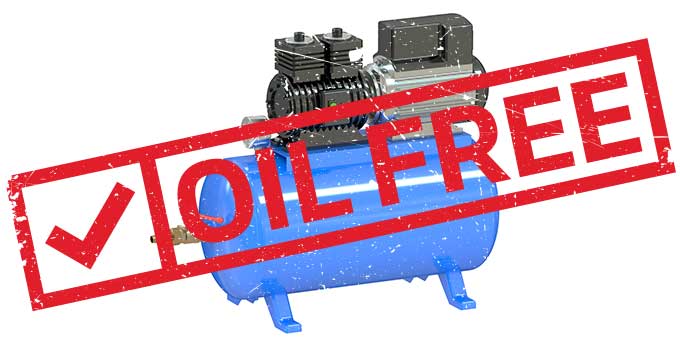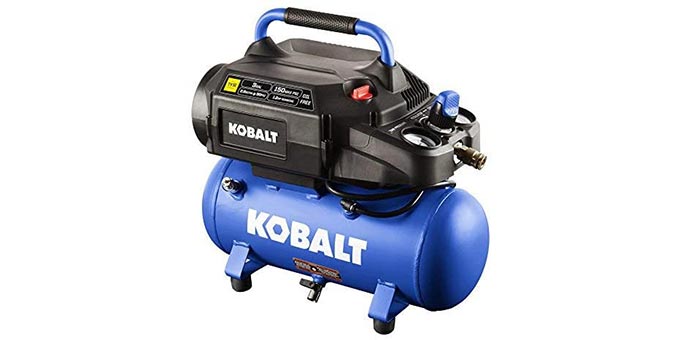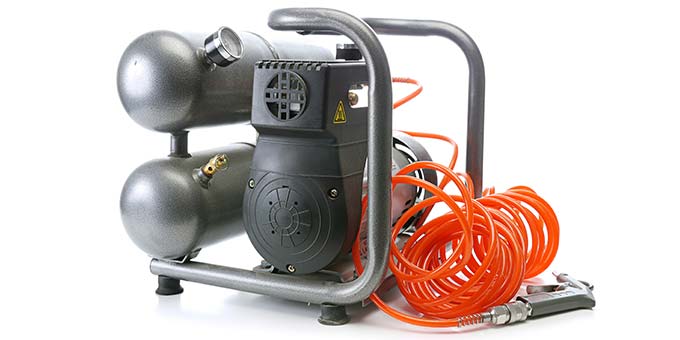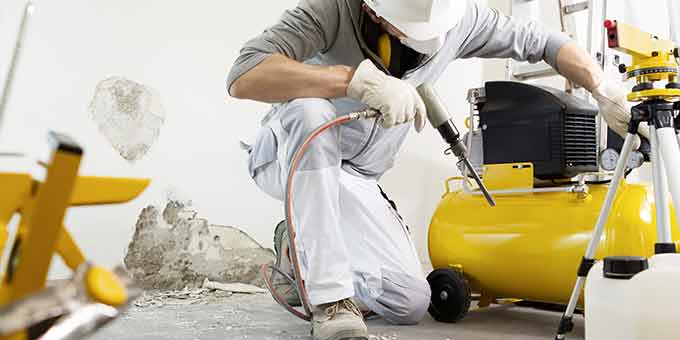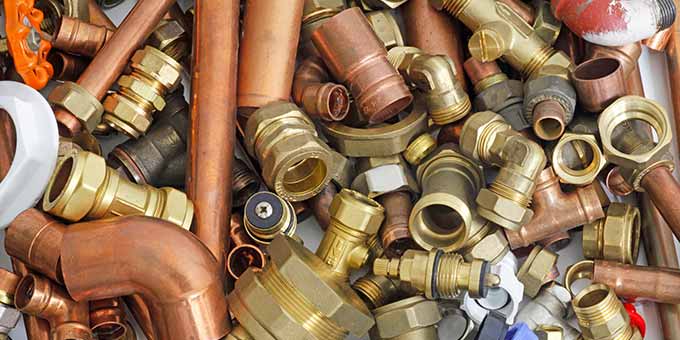The air purity of compressed air is only as good as the source it comes from. If the process of filling the tank becomes hindered by oil, it can be more challenging to keep the air quality consistent, increasing the cost of using your oil air compressor.
To counter this problem, many companies are turning to oil-less air compressors or oil-free air compressors. In this day and age, oil-free compressors are becoming a household machine because they can offer cost-saving and be used for many reasons.
How Oil-Free Air Compressors Work
Oil-free air compressors use an alternative material to protect the mechanism without lubrication or mechanical contact inside its chamber. Typically, most oil-free air compressors utilize a Teflon coating or water to keep the tool running efficiently.
The machine needs lubrication of its gears and bearings, sometimes leading to the oil leaking through the seal around the air tank. It’s recommended to check all seals to ensure the compressed air is not contaminated by the seepage. This results in an oil-free air supply that is 100% free of any pollution or debris.
Eliminating the need for synthetic and oil-based lubrication has been done by removing the metal-to-metal contact within the compression chamber of some oil-free designs. These environmental and purity benefits may reduce overall ownership costs while translating into other savings. Here are some things to consider if you are thinking about changing to an oil-free model:
- Downstream filters have lower replacement requirements because they are not filtering oil
- These units can unload within two seconds of pressing the unload command and uses about 17% of their total load horsepower when empty
- Reduced oil costs because there is no need to refill your air compressor continuously
- Energy costs are minimized because there is no need to increase the force required to fill the tank
- Some fluid flooded units can see downstream pressure drops due to the filtration system failing
- There is no need to collect or dispose of oil ladened condensate in a lubricant-free compressor
These sorts of savings can be very tempting for anyone looking to invest in an oil-free air compressor. If you want to use an oil-free air compressor, you first need to understand how the compressor works and what different models work best for particular applications.
Class Zero Air and Oil-Free Compressors
The phrases “technically oil-free” and “oil-free” are usually used to identify air purity in a compressor. Depending on the air compressor rankings, these phrases correlate with international regulations that are set worldwide. The standards are set by ISO (International Organization for Standardization) and manufacturers are conscientious about this grading.
Air Compressor Ranking
If you want to know how air compressors are ranked, it’s good to know how clean the air is after filling the compressor tank. The most hygienic choice for sensitive applications is Class Zero air, as it is the highest quality oxygen possible.
- An oil-free air compressor meets ISO Class Zero certifications and is the perfect tool for delicate jobs requiring a clean air supply. While an oil-free compressor may have higher first-time costs, it allows no contamination to reach the end product and is generally safer.
- Ranked as ISO Class 1, “technically oil-free” air compressors are at risk of contamination because of oil-lubricated models in the range. During compression, the machine uses oil-removing filters to eliminate most grease particles. However, it’s imperative to note that these air compressors cannot deliver 100% oil-free air.
Oil Injected vs. Oil-Free Compressor
Depending on your specific applications, the best air compressor for your project could be oil-injected or oil-free. Oil-free compressed air must be used for any application where oil contamination can cause product spoilage or damage production equipment. An oil-less air compressor like this is the ideal solution providing the highest air clarity standards when busy with your processes.
In contrast, oil-lubricated compressors can last longer and typically have a more durable design.
When you don’t know what to choose between an oil-less air compressor or an oil-lubricated air compressor, a few considerations are vital to finding a suitable one. Keep reading to find out how to locate the best compressor for your requirements:
- Noise levels: Typically, oil-injected compressors produce more noise than oil-free models but have higher durability as a result of the lubrication
- Air quality: Oil-less compressors provide the most premium air quality possible, meaning there is no risk of contamination to your end product
- Energy usage: An oil-free compressor is more energy-efficient and minimizes leaks, which can help keep your energy bill low and cut maintenance costs
- Environmental impact: Oil-free compressed air ensures better compliance with environmental protection enforced by international standards
Oil-injected air compressors may be a cheaper option for jobs that don’t require the advantage of maintaining safety or improving efficiency. However, an oil-free air compressor is necessary when the risk of oil leakage is too high, such as in medical services or food processing industries.
Functional Steps of How Oil-Less Air Compressors Work
Understanding why these air compressors last so long and how it works is crucial to finding the application it best fits. Let’s talk about how to start working with an oil-less air compressor and learn how it provides the prescribed amount of compressed air.
Below we discuss how filing the compressor tank works and how it keeps the air cool.
Drawing in Air
Oil-free compressors begin by sucking in air from the outside through the inlet air filter, ensuring no moisture or contamination risks enter the tank; that is essential to get only quality compressed air. The filter also limits harm to the compressor’s internal components, lowering operating costs and increasing energy efficiency.
Customers rely on these filters as the perfect solution to keep out small debris, grease, dirt, and dust, so their air compressor runs at optimal performance. Sensitive applications require a high level of sanitation, such as the fashion or dentist industries.
First Compressor Element
In most cases, an air compressor creates heat due to the low-pressure element inside of the machine. One of the main reasons it produces so much heat is because these compressors work without oil.
On average most compressors operate at around 2.6 bar, with most units operating at temperatures up to 190 degrees. Typically, that is twice as high as a competing oil unit due to the lack of cooling and no flowing medium to dissipate the heat in the small area.
In an oil-free system, the air is compressed and then is transported through the machine for cooling. After that, it can be used in one of many applications throughout multiple industries.
Intercooler Access
Once the air is compressed, a piston drives the essential oxygen through the system to an intercooler. The air needs to lower in temperature so that it can be compressed further. Depending on the compressor and specific application, the air moves to the final or the second compression phase.
Air pressure generates heat that restricts oxygen content, thus interfering with the density; using it for pneumatic tools could be a problem if you need the machine to pump clean oxygen regularly.
Cooling the system allows the technology to produce more oxygen-rich air, which improves the power output and provides more fuel when the machine is working with a combustion engine.
Second Higher Pressure Compression
After the previous step, the air moves back to the main chamber, increasing the pressure depending on the design efficiency. The maximum pressure achieved by most air compressors is generally between 115 to 146 psi. Once again, the oxygen becomes hot because of the lack of permanent lubrication and requires cooling a second time.
Air Prep and Aftercooler Access
During the second compression stage, temperatures can rise to 145 degrees, which means it needs to be cold before exiting the machine. The rotary screw is the perfect solution for keeping the oxygen inside of the device while it passes through the aftercooler. While passing through the intercooler technology, the air is controlled by pulsation dampeners, which help reduce vibrations caused by the oxygen moving through the system.
These pulsations and vibrations affect how air compressor technology operates, so companies have to install these safeguards into these machines.
Pressure Switches
The pressure switch is a button used to send power to compressors and helps monitor the force built up within the tank. When the air containment pressure drops below a certain level, the machine turns back on to repressurize the air and send it to the oxygen compartment.
Once stored, the air can be released through the hose via an air gun or another pneumatic tool.
Conclusion
We hope that you now understand how oil-free oxygen compressors work and what sort of energy savings they can offer you. It is good to know that maintenance on this technology is near non-existent, and if treated correctly, most machines can last for life.
Whether in a different country or the USA, oil-free compressors deliver the power and oxygen needed in many industries and applications. A quick search online can reveal the many models available in and outside of the USA.


